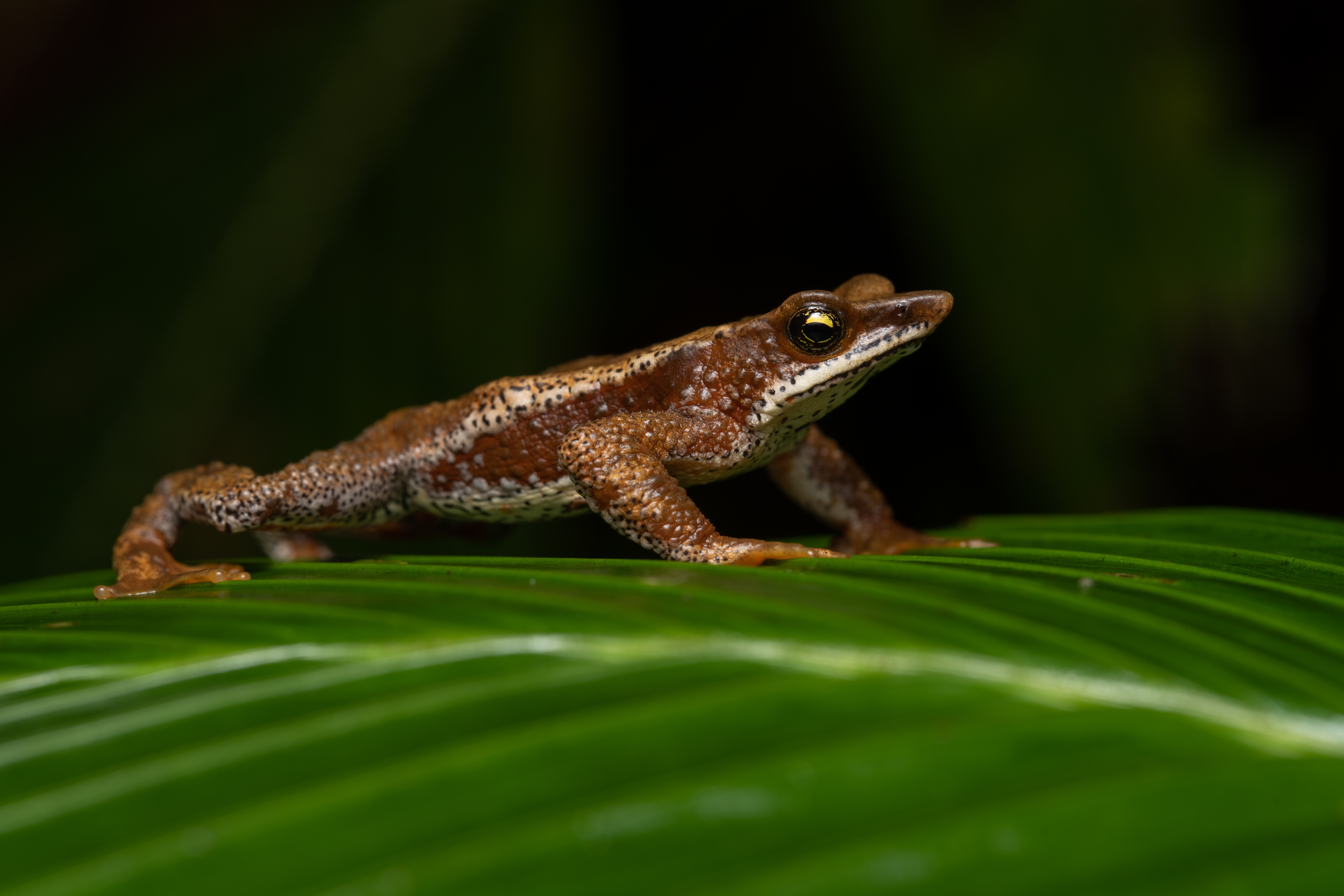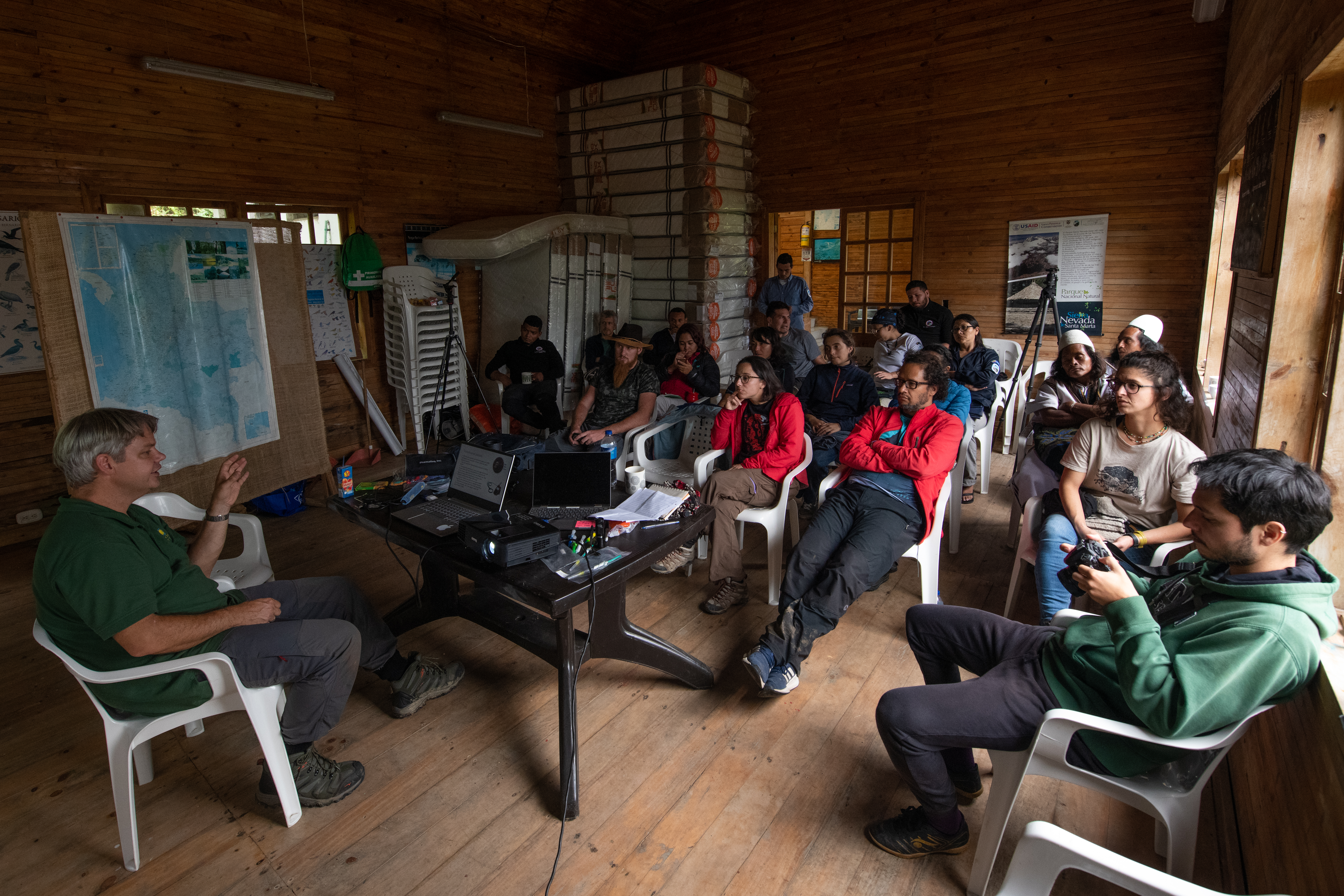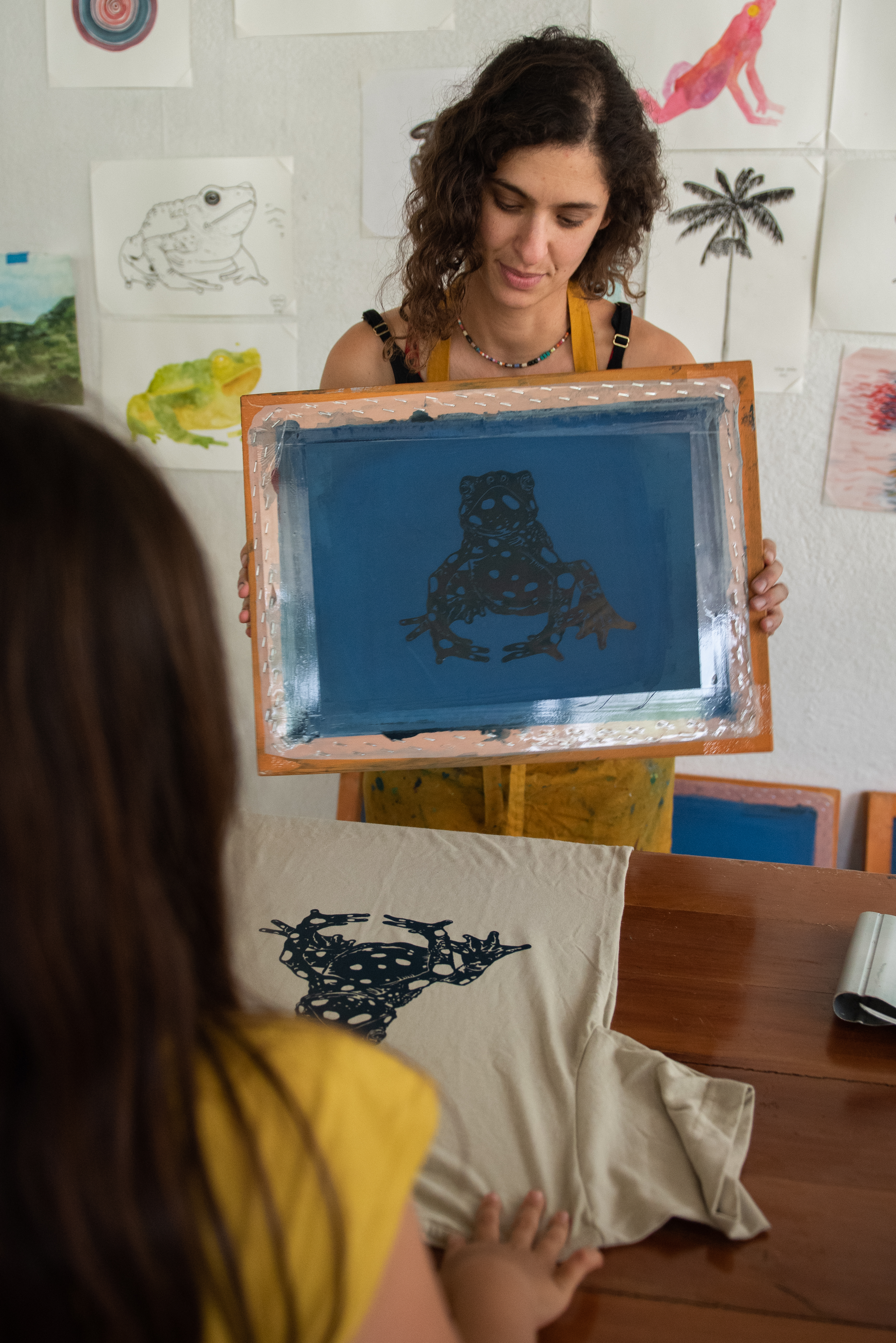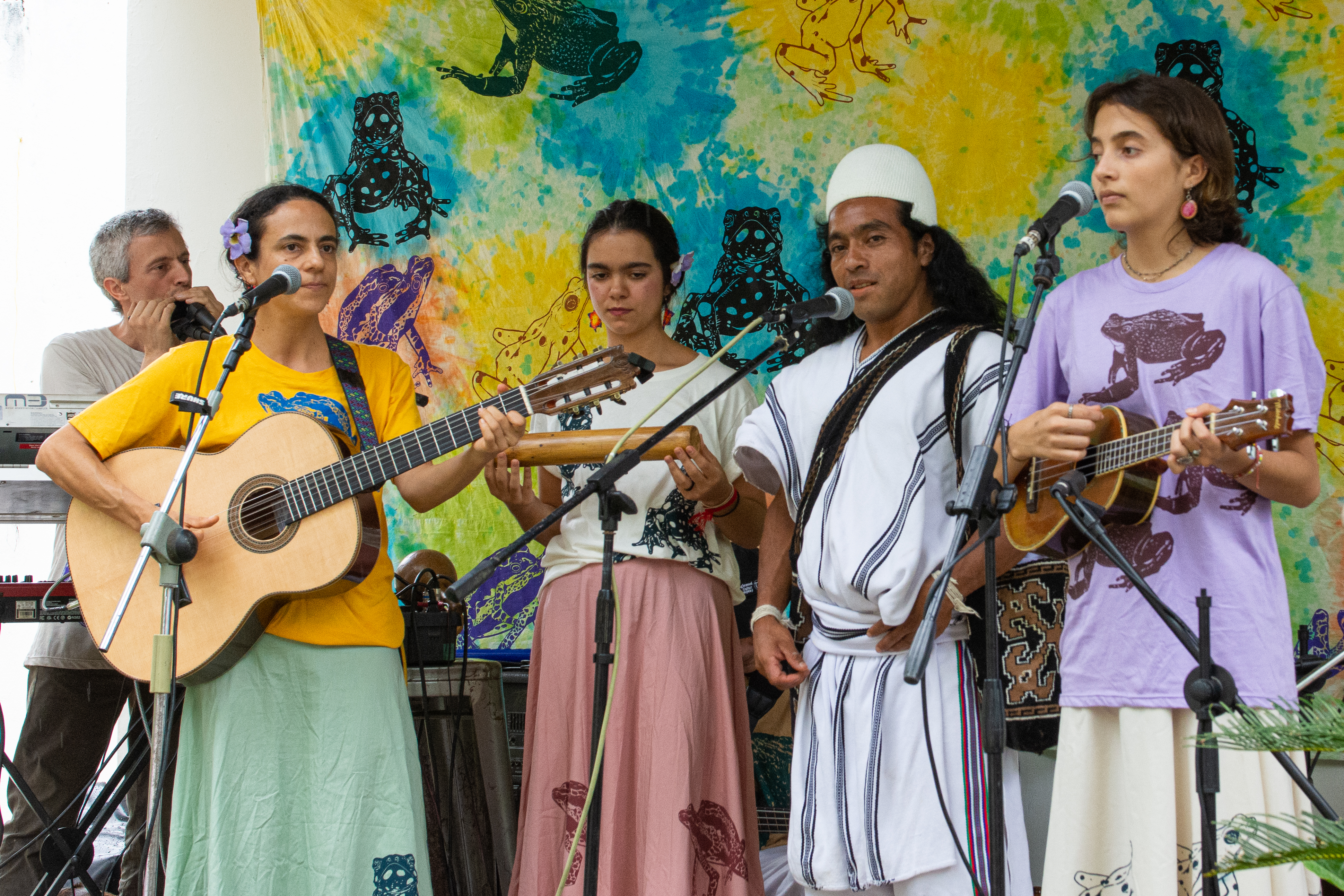In August 2022 a diverse team of researchers, conservationists, artists, and representatives of local and Indigenous communities and park rangers met at Estación Experimental San Lorenzo in the Sierra Nevada de Santa Marta, Colombia with one common objective in mind: studying and preserving Harlequin Toads (genus Atelopus). The meeting was part of the project “The last refuge of Harlequin Toads: working together to save the jewels of the forest”, funded by the National Geographic Society. The project involves a large group of people and organizations, including several Amphibian Survival Alliance (ASA) partners, ASA Future Leaders of Amphibian Conservation and members of the Atelopus Survival Initiative (ASI). The partnership between scientists, conservationists, artists, and educators resulted in the creation of scientific protocols for research and monitoring of Atelopus and the publication of a children’s book and songs about Harlequin Toads.
Harlequin Toads, the Jewels of the Neotropics
Harlequin Toads are terrestrial amphibians, with striking and bright colors that inhabit several countries in Central and South America. These toads live from open areas (such as the Andean Páramos) to densely forested regions (such as the Amazonian rainforest) where they can be usually found near small streams with clear running water.
Harlequin Toads are one of the most highly threatened groups of animals in the world, with about 80% of all species currently listed as Critically Endangered, Endangered or Vulnerable in the IUCN Red List of Threatened Species. It is believed that up to 40% of Atelopus species may be extinct in the wild, whereas some of these only still exist thanks to ex situ conservation programs that maintain populations in captivity. The biggest known threats to Harlequin Toads are deforestation, water contamination, invasive species, and especially, infectious diseases. Among the diseases, the most lethal is chytridiomycosis (disease caused by the fungus Batrachochytrium dendrobatidis)—often referred to as the amphibian pandemic.
Because they are extremely threatened, Harlequin Toads receive special attention from the scientific community. The ASI was created from the urgency of implementing strategies for the conservation of Atelopus species. The ASI unites more than 100 individuals from more than 40 organizations in 15 countries dedicated to studying and conserving Atelopus. Rather than isolated stars the ASI is a constellation of champions working together to bring Harlequin Toads from the brink of extinction. Several ASI members are also National Geographic explorers, and these explorers seized on the opportunity to get funded by the Society to work on a project that brought them together to exchange experiences and think about strategies for the conservation of Atelopus.

San Lorenzo Harlequin Toad (Atelopus nahumae), only known from the Sierra Nevada de Santa Marta, Colombia, currently listed as Endangered by the IUCN (Photo: Pedro Peloso).
Meeting at Sierra Nevada de Santa Marta, Colombia
The Sierra Nevada de Santa Marta, Colombia, is a special place due to its incredible biological and cultural diversity. More than preserving an enormous diversity of animal and plant species that exists nowhere else in the world, the region is inhabited by four indigenous communities (Arhuaco, Kankuamo Kogui and Wiwa) who have lived in the region for centuries (at least 200 years BC). The Sierra Nevada is located only a few kilometers from the Atlantic coast and consists of a mountain range that reaches altitudes of more than 5500 meters—it is considered the highest coastal mountain in the world. These mountains harbor five endemic species of Atelopus in its streams, some of which are at high risk of extinction because of their extremely small geographic distributions. But unlike many other places where the genus occurs, in Santa Marta most of these species have populations that are stable and healthy. The researchers involved in the “Last refuge of Harlequin Toads” project believe that understanding the reasons why these populations persist in the wild despite threats can provide critical information for the development of conservation strategies for the group, in Colombia and elsewhere.
Over one week all participants shared lessons of success and failures on Harlequin Toad research and conservation and demonstrated different field methods used in Atelopus research. At the end of the project, the researchers promised to deliver a protocol that will be shared with the ASI and the rest of the scientific community, and that can be used as a starting point for future research and conservation projects with Harlequin Toads throughout Central and South Americas.

Art and Education for Biodiversity Conservation: Singing to Save Harlequin Toads
The most beautiful and transforming moments of the expedition were the activities carried out with local communities, where the Colombian music group Jacana Jacana held concerts together with environmental education activities aimed at children. The events took place in a public school in La Tagua and in a private music hall in Minca. The concerts were predominantly attended by children, who were charmed by the beautiful songs created and performed by Jacana Jacana. The group is composed of musicians and educators with a strong background in creating and leading educational projects that aim to reconnect the public with themes of nature–their creative songs include diverse rhythms and celebrate the biodiversity of Latin American forests.
As part of this project the team selected four iconic species of Harlequin Toads from four different countries, and for each of them Jacana Jacana composed a unique song. The lyrics, developed together with researchers and local communities working in the conservation of each species, include elements related to the amphibians and the culture of the country where they occur. The four songs were performed live for the first time during the concerts in Colombia. Before and after the shows, educational activities were carried out with the children, including printing of t-shirts and posters with images of the four harlequin toad species, and the distribution of the trilingual book “Harlequin Toads, Jewels of our Forests and Páramos”. The book includes texts written by the researchers and are accompanied by beautiful illustrations by Colombian artist Sara Ramirez. The published songs, along with music videos exclusively produced for the project, are available, respectively, on Spotify and Youtube by Jacana Jacana.
The release of the first song coincided with the launch of the Jambato Alliance (22 September 2022), an effort to study and preserve the Jambato Harlequin Toad (A. ignescens) in Ecuador. The song is a tribute to the species locally known as Jambato Negro. Scientists believed this species, like other Atelopus, was extinct, until it was rediscovered in 2016 by a child playing in his garden. The other three species chosen to be honored with a song were: A. manauensis from Brazil (song released October 12, 2022), A. arsyecue from the Sierra Nevada in Colombia, and A. zeteki from Panamá, a species considered to be extinct in the wild that only survives in captive breeding centers.

Colombian artist Sara Ramírez from Selva Selvita (instagram: @selvaselvita) illustrated the book and led educational activities during our work in Colombia, which involved silk printing of t-shirts and posters for the kids (Photo: Pedro Peloso).
A Constellation, Rather Than Isolated Stars, to Save Harlequin Toads
The group that met in Santa Marta was composed of conservationists, researchers, educators, and artists directly involved with Harlequin Toad conservation, as well as local park rangers and leaders and members of the Arhuaco Iindigenous communities. A total of 24 people from 9 different countries participated in the gathering in Colombia. This cultural and intellectual diversity was essential to the success of the expedition and in solidifying the group as a team that shares a solid goal—to secure a future for Harlequin Toads.
The team was led by Lina Valencia, coordinator of the IUCN SSC Amphibian Specialist Group Atelopus Task Force, and Luis F. Marin da Fonte, coordinator of the ASI and Director of Partnerships & Communications at the Amphibian Survival Alliance. Other team members were Jeferson Villalba, José Luis Peres, and Sintana Rojas (ASA partner Fundación Atelopus), Brian Gratwicke (ASA partner Smithsonian Conservation Biology Institute), Pedro Peloso (ASA Future Leader of Amphibian Conservation), Juan Manuel Guayasamin (Jambato Alliance), Janni Benavides, Julia Alvarez and Andrés Alvarez (Jacana Jacana), Delia Basanta (University of Nevada), Mirna Garcia-Castillo (Universidad Nacional Autónoma de México), Ruperto Chaparro and Rufino Arroyo (Arhuaco Indigenous community), Sara Ramírez (Selva Selvita), Timothé Le Pape (Cerato, Association Herpétologique de Guyane), and Lilia Mejia, Anibal Benitez, Jorge Meza, Elmer Ortega and Angela Arias (Parques Nacionales Naturales de Colombia). Additional team members that were not able to join the fieldwork activities include Luke Linhoff (Smithsonian Conservation Biology Institute) and Jamie Voyles (University of Nevada).
See an additional story and images of the project in National Geographic in Spanish and Portuguese.
——-
Caption first image: A prominent member of the Arhuaco indigenous community from Sierra Nevada took the stage to talk about the importance of preserving the Starry Night Harlequin Toad (Atelopus arsyecue) during a concert performed by Jacana Jacana in Minca. From left to right: Andrés Alvarez, Janni Benavides, Ona Gabriunas, Ruperto Chaparro (Arhuaco), and Julia Alvarez. (Photo: Luis Marin da Fonte)
——-
Text by Pedro Peloso1,2,3, Janni Benavides3,4, Lina Valencia3,5,6, and Luis Fernando Marin da Fonte3,6,7

